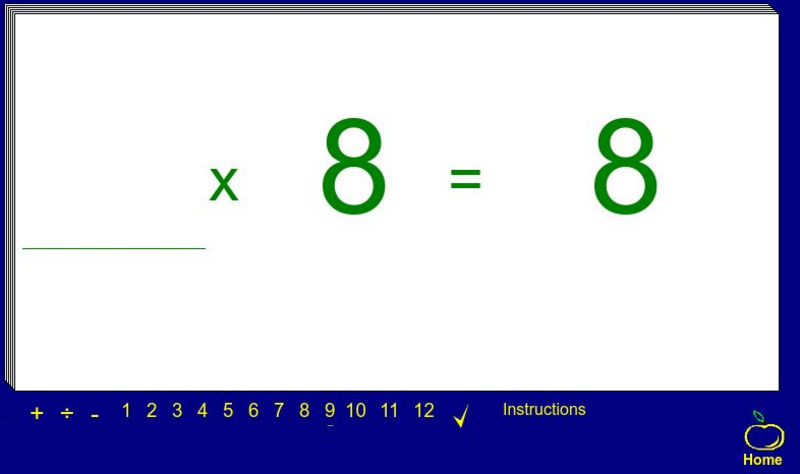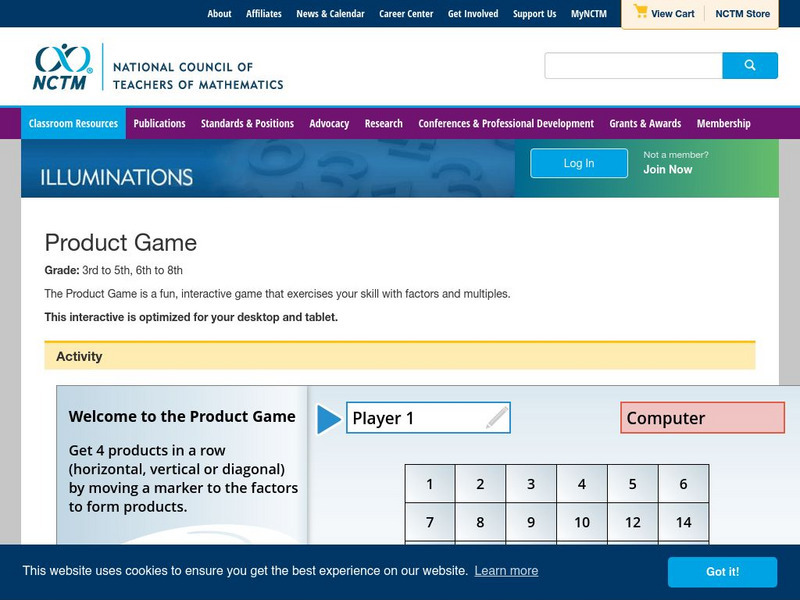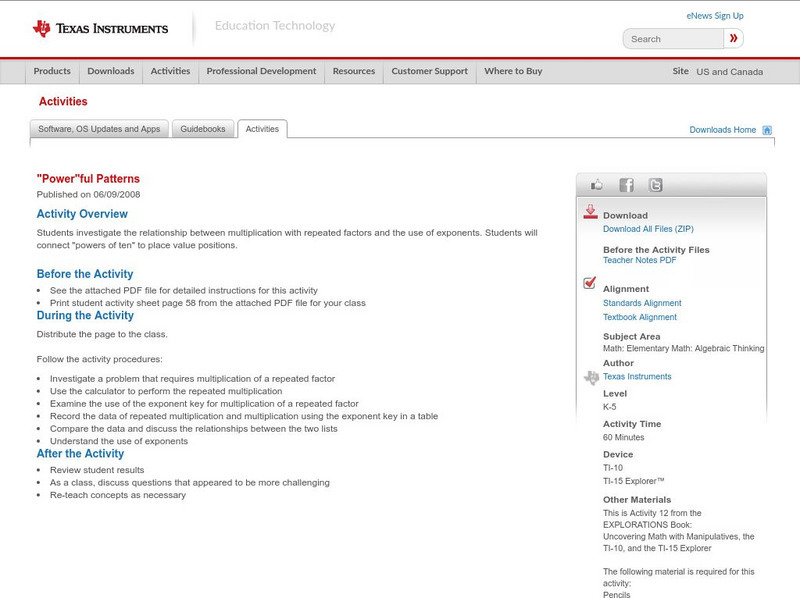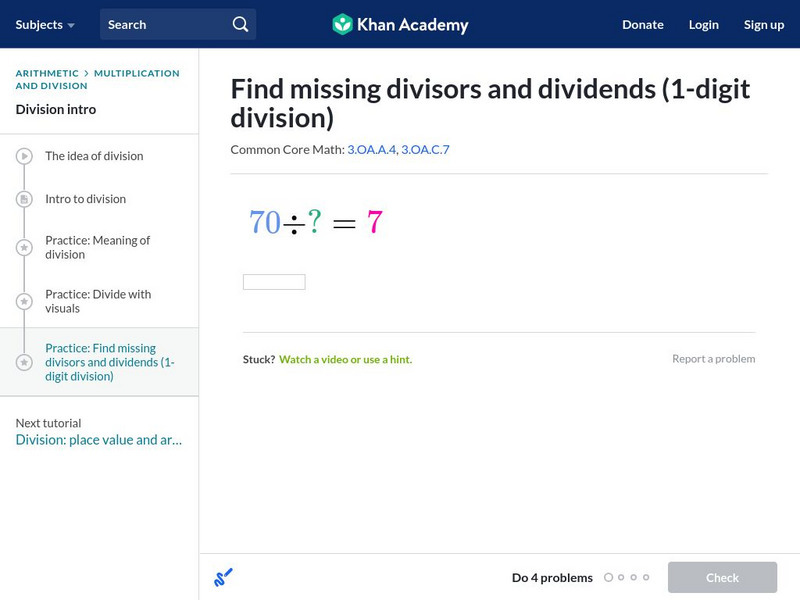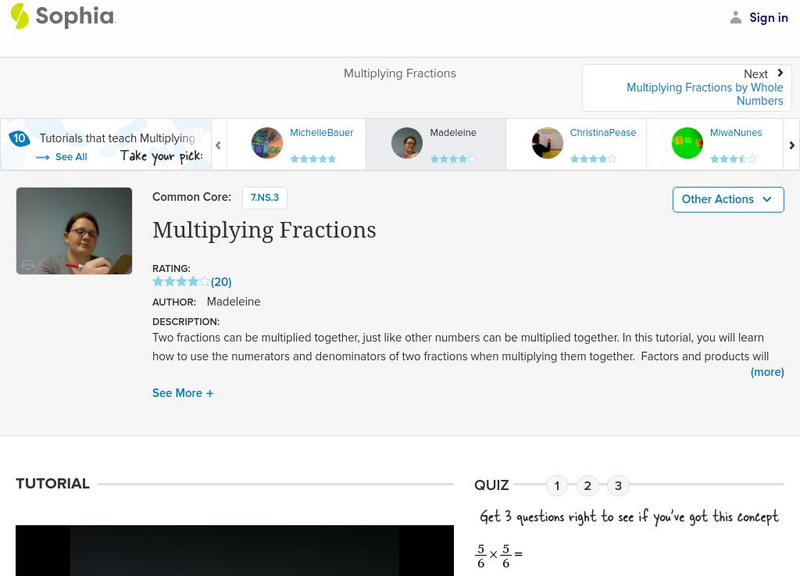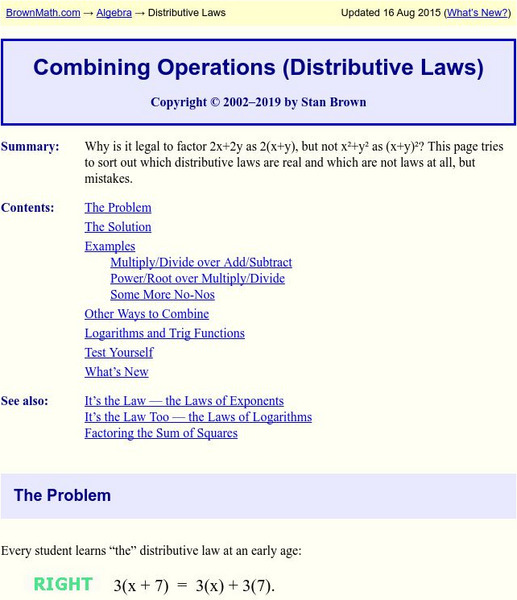Hi, what do you want to do?
Louisiana Department of Education
Louisiana Doe: Louisiana Believes: Eureka Math Parent Guide Multip, Div With Units of 0, 1, 6 9, and Multiples of 10
A guide to support parents as they work with their students in multiplication and division with units of 0, 1, 6-9, and multiples of 10.
Other
Multiplication: An Adventure in Number Sense
This explanation for learning your multiplication tables is interactive and fun. There are only about 13 facts that students may want to memorize.
NumberNut
Number Nut: Multiplying More Than Two Factors
Multiplying by more than one factor can be easy when you break the numbers down. Learn this problem solving strategy and others in this short lesson that demonstrates how to multiply with several factors. This lesson includes specific...
Mr. Martini's Classroom
Mr. Martini's Classroom: Multiplication Cards, Fill in the Blank
Students solve multiplication facts on these interactive flashcards. The problem changes color when the correct number is typed.
Visual Fractions
Visual Fractions: Rename in Higher Terms With Lines
Rename fractions in higher terms with this interactive module. Number lines are used for fractional representations. Detailed instructions, practice opportunity, and immediate feedback provided for this concept....
Alabama Learning Exchange
Alex: Burst Into Jolly Multiplication/division Factors
The following lesson will serve as a hands-on math activity reviewing the 2's and 3's multiplication and division factors. Students will examine the relationship between multiplication and division using Starburst and Jolly Rancher candy...
Math Planet
Math Planet: Polynomial Equations in Factored Form
All equations are composed of polynomials. If you know how to solve equations containing polynomials of the first degree, then you can solve equations of higher degree. One way to solve a polynomial equation is to use the zero-product...
National Council of Teachers of Mathematics
Nctm: Illuminations: The Product Game
In the Product Game, students start with factors and multiply to find the product. There are four parts to this investigation.
Texas Instruments
Texas Instruments: "Power"ful Patterns
For this activity, middle schoolers investigate the relationship between multiplication with repeated factors and the use of exponents. Students will connect "powers of ten" to place value positions.
Homeschool Math
Homeschool Math: Prime Factorization
This site contains a free lesson on Prime Factorization in which students learn by doing practice problems.
Other
Visual Fractions: Rename in Higher Terms With Circles
Practice renaming fractions in higher terms using circle fractions, in this Java applet interactive game. A simple activity for most. However, if you get stuck, see the detailed, directions and examples that are included.
Alabama Learning Exchange
Alex: To Scale or Not to Scale? That Is the Factor.
Middle schoolers will learn to solve proportions and find missing sides of similar figures using the scale factor. This lesson is best taught before the concept of cross multiplication is developed. Not only will the student learn the...
Khan Academy
Khan Academy: Find Missing Divisors and Dividends (1 Digit Division)
Find missing divisors and dividends in 1-digit division problems. Quotients are less than or equal to 10. Students receive immediate feedback and have the opportunity to try questions repeatedly, watch a video tutorial, or receive hints....
Sophia Learning
Sophia: Multiplying Fractions
Students review how to multiply two fractions in this lesson. The video tutorial consists of examples that explore how to multiply fractions and a quiz is provided to test students' knowledge of the skill.
CK-12 Foundation
Ck 12: Elem Math: Finding the Number From the Figure Patterns
[Free Registration/Login may be required to access all resource tools.] For this learning module, students are asked to identify multiplication patterns and to use their division facts to fill in missing factors. Includes video...
Illustrative Mathematics
Illustrative Mathematics: 5.nf Grass Seedlings
For the sake of this commentary, let R be the height of Rual's seedlings (of course students do not need to use a letter to represent any number in this task). Student must compare the size of each of two products (112xR, and 34xR) to...
University of Cambridge
University of Cambridge: Maths and Sports: Going for Gold
Looking at the 2008 Olympic Medal table, can you see how the data is organised? Could the results be presented differently to give another nation the top place? This activity encourages children to develop their skills in data analysis,...
University of Cambridge
University of Cambridge: Maths and Sports: Olympic Logic
Four sporty brainteasers in the context of fencing, hockey, football and international medal tables. This activity challenges students to be resourceful, to think logically and to work systematically, and is designed to be accessible to...
University of Cambridge
University of Cambridge: Maths and Sports: Medal Muddle
Can you work out which order these thirteen nations finished in after competing? This activity presents an exercise in strategic thinking, accessible to lower secondary students (but hinting at the more advanced mathematics of sorting...
Other
Brown Math: Distributive Laws and Mistakes
Why is it legal to factor 2x+2y as 2(x+y), but not x sauared +y squared as (x+y)squared? This site there are the distributive laws are separated from the distributive "mistakes," in an easy-to-understand discussion. Logarithms and trig...
TeachEngineering
Teach Engineering: On Track Unit Conversion
Students use three tracks marked on the floor, one in yards, one in feet and one in inches. As they start and stop a robot specific distances on a "runway," they can easily determine the equivalent measurements in other units by looking...
Better Lesson
Better Lesson: Tubing Tens Cool Off With an Imaginary River Adventure
If you know how to count by tens, you can solve multiplication problems in which ten is a factor.
Calculator Soup
Calculator Soup: Volume Conversion Calculator
In this volume calculator, conversions are performed by using a conversion factor. By knowing the conversion factor, converting between units can become a simple multiplication problem.







